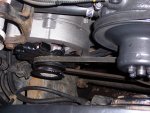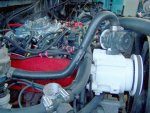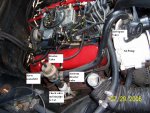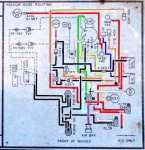Here are some of them, if you have a question on any others, put them in a post on this thread.
A/CL DV Air Cleaner Diverter Valve (located in the horn on the air cleaner)
EXH HCV Exhaust Heat Control Valve (Used to be called a Heat Riser, for start and run characteristic)
ACV Air Control Valve or Air Diverter Valve (directs air pump air to manifold or cat depending on engine conditions)
PCV Positive Crankcase Control Valve (direct oil fumes from crankcase to intake manifold)
EGR Exhaust Gas Recirculation valve (reduces air pollutants)
MAN VAC Main Vacuum port (supplies vacuum to various components)
SV-CBV Solenoid Valve Control Bowl Valve (closes off the bowl vent line when the engine is running)
TVV Thermal Vent Valve (controls at what temperature fumes are passed to the carbon canister)
VCKV Vacuum Check Valve (sort of like a one way street for vacuum flow)
TK Throttle Kicker (used with A/C to keep the RPM up when A/C is on)
C/O HCV Intake Manifold Heat Control Valve ( works with the other HCV to return some exhaust into the intake to worm up the fuel mixture while the engine is cold)
IVV Idle Vacuum Valve (vents vacuum to the atmosphere under certain conditions)
V Restr Vacuum restrictor (prevents sudden change in vacuum level)
SOL V Solenoid Valve (used for various vacuum control functions)
VCS Vacuum Control Switch (an electrical switch operated by vacuum)
Thanks seabronc, that definately helps.
In the next day or so I will have a question about a long wire harness in the enging compartment. It is not connected to anything in the engine compartment. It has about 5 or 6 different types of plugs along its length and ends with a red plug that has 3 wires going into it. In the next day or two I will get a pic of it so you can see what it looks like.
Bill
VCV Vacuum Control Valve (a heat operated valve that controls the flow of vacuum)
Purge CV Purge Control Valve (controls the evacuation of fumes from the evaporative emissions carbon canister)
Air BPV Air Bypass Valve (dumps the air from the air pump overboard under certain engine conditions)
FLTR Filter ( a small filter over a port on a VCV to prevent dirt from entering when the valve is open to the atmosphere)
On the carb
BV Bowl Vent (allows fumes from the float chambers to be collected by the storage tanks, part of evaporative emissions control)
EGR EGR vacuum port (vacuum source for the EGR)
S Spark port (supplies vacuum for the vacuum advance)
ALT used on altitude adjustable carbs (for high altitude air mixture adjustment)
Hope that helps,

>-




